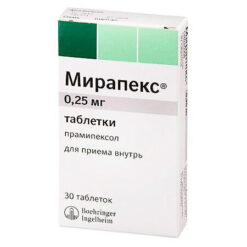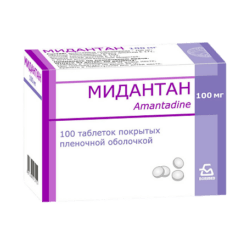-
×


-
×


Subtotal: €32.92




Subtotal: €32.92




Subtotal: €32.92
€10.68 €9.34
Pronoran has antiparkinsonian effects.
Pharmacodynamics
The active substance pyribedil is an agonist of dopaminergic receptors. It penetrates the cerebral bloodstream, where it binds to dopaminergic receptors in the brain, exhibiting high affinity and selectivity for dopaminergic receptors type D2 and D3.
Piribedil’s mechanism of action accounts for the major clinical properties of the drug for the treatment of Parkinson’s disease in both the initial and later stages of the disease with effects on all major motor symptoms.
Piribedil exhibits antagonist activity at two major CNS α-adrenergic receptors (type α2A and α2C) in addition to acting on dopaminergic receptors. The synergistic effects of pyribedil as an α2 receptor antagonist and dopaminergic brain receptor agonist have been demonstrated in various animal models with Parkinson’s disease: long-term use of pyribedil results in less severe dyskinesia than levodopa use, with similar effectiveness against the reversible akinesia associated with Parkinson’s disease.
In pharmacodynamic studies in humans, cortical dopaminergic electrogenesis has been shown to be aroused, both on awakening and during sleep, with demonstration of clinical activity in relation to various dopamine-controlled functions, this activity has been demonstrated using a behavioral or psychometric scale. In healthy volunteers, piribedil has been shown to improve attention and alertness related to cognitive tasks.
The efficacy of Pronoran® as monotherapy or in combination with levodopa in the treatment of Parkinson’s disease has been studied in three double-blind placebo-controlled clinical trials (2 studies compared to placebo and one compared to bromocriptine). The studies enrolled 1,103 stage 1-3 patients on the Hoehn & Jahr scale, 543 of whom received Pronoran®.
Pronoran® at a dose of 150-300 mg/day has been shown to be effective in acting on all motor symptoms with 30% improvement on the Uniform Parkinson’s Disease Rating Scale (UPDRS, part III – motor) over 7 months for monotherapy and 12 months in combination with levodopa. Improvement on part II of the UPDRS scale, activity of daily living, was rated at the same values.
In monotherapy, the statistically significant proportion of patients needing emergency levodopa treatment who received pyribedil (16.6%) was lower than in the group of patients receiving placebo (40.2%).
The presence of dopaminergic receptors in lower limb vessels explains the vasodilatory effect of pyribedil (increases blood flow in lower limb vessels).
Pharmacokinetics
Piribedil is rapidly and almost completely absorbed from the GI tract and is intensely distributed.
The Cmax of piribedil in plasma is reached 3-6 h after oral administration of the controlled-release dosage form. Binding to plasma proteins is medium (unbound fraction is 20-30%). Due to low binding of pyribedil to plasma proteins the risk of drug interaction when used with other drugs is low.
Plasma elimination of pyribedil is biphasic and consists of an initial phase and a second slower phase leading to maintenance of sustained plasma concentrations of pyribedil for more than 24 hours.
In a combined pharmacokinetic analysis, the T1/2 of pyribedil after IV administration was shown to average 12 h and was independent of the dose administered.
Piribedil is extensively metabolized in the liver and is excreted primarily in the urine: 75% of absorbed piribedil is excreted by the kidneys as metabolites.
Active substance:
Piribedil 50 mg;
Associates:
magnesium stearate, 5 mg;
povidone, 20 mg;
talc, 130 mg;
Shell:
Sodium carmellose -0.71 mg;
Polysorbate 80 -0.3 mg;
Ponceau 4R crimson dye – 3.87 mg;
povidone – 6.31 mg;
sodium bicarbonate -0.15 mg;
colloidal silica -0.27 mg;
sucrose – 57.17 mg;
p> talcum 50.37 mg;
titanium dioxide – 0.78 mg;
beeswax white – 0.07 mg
Overly, after meals, without chewing, with 1/2 cup of water.
For all indications except Parkinson’s disease, 50 mg (1 tablet) once a day. In more severe cases, 50 mg 2 times a day.
Parkinson’s disease: monotherapy – 150 to 250 mg (3 to 5 tablets) per day, recommended divided into 3 doses; if a 250 mg dose is needed, 2 50 mg tablets in the morning and afternoon and 1 tablet in the evening are recommended; in combination with levodopa drugs, 150 mg (3 tablets) per day, recommended divided into 3 doses.
When adjusting the dose if increasing, it is recommended that the dose be titrated, gradually increasing by 1 tablet (50 mg) every 2 weeks.
Because of the mutual antagonism between dopaminergic anti-Parkinsonian drugs and neuroleptics, concomitant administration with neuroleptics (except clozapine) is contraindicated.
1. Patients with extrapyramidal syndrome caused by taking neuroleptics should receive therapy with anticholinergic drugs and should not receive dopaminergic antiparkinsonian drugs (due to blocking of dopaminergic receptors by neuroleptics).
2. dopaminergic anti-Parkinsonian drugs can cause or exacerbate psychotic disorders. If neuroleptic prescribing is required in patients with Parkinson’s disease treated with dopaminergic antiparkinsonian drugs, the dose of the latter should be gradually reduced until finally withdrawn (abrupt withdrawal of dopaminergic drugs is associated with the risk of malignant neuroleptic syndrome).
3. antiemetic neuroleptics (antiemetic medications that do not cause extrapyramidal symptoms should be used).
Because of the mutual antagonism between dopaminergic antiparkinsonian drugs and tetrabenazine, concomitant administration of these drugs is not recommended.
Piribedil should not be used with alcohol.
Piribedil should be used with other drugs with sedative effects.
In some patients (especially in patients with Parkinson’s disease) against the background of taking Piribedil a state of severe drowsiness sometimes occurs suddenly, up to sudden falling asleep. This phenomenon is extremely rare, but nevertheless, patients who drive a car and/or work on equipment requiring a high degree of attention should be warned about it. If such reactions occur, consideration should be given to reducing the dose of Piribedil or discontinuing therapy with this drug.
Perhaps the risk of falls, which may be caused by sudden falling asleep, hypotension, or confusion, should be considered given the age of the population receiving piribedil therapy.
Patients and their caregivers should be alert to possible behavioral disorder symptoms (gambling tendencies, increased libido and hypersexuality, compulsive shopping and compulsive overeating) when taking the drug. If these symptoms occur, dose reduction or gradual discontinuation of therapy with the drug should be considered.
The crimson dye in this drug increases the risk of allergic reaction in some patients.
Impact on the ability to drive vehicles and mechanisms. Patients who have had episodes of severe somnolence and/or sudden falling asleep during therapy with Piribedil should refrain from driving vehicles and equipment requiring a high degree of attention until these reactions disappear.
With caution: Because the drug contains sucrose, patients with fructose, glucose, or galactose intolerance or patients with sucrose-isomaltase deficiency (a rare metabolic disorder) should not take the drug.
Gastrointestinal side effects: minor gastrointestinal symptoms (nausea, vomiting, flatulence), these side effects are reversible with selection of an appropriate individual dose. Dose adjustment by gradually increasing the dose (50 mg every 2 weeks until the recommended dose is reached) leads to a significant reduction in the occurrence of these side effects.
CNS disorders: Psychiatric disorders such as confusion, hallucinations, agitation or dizziness may occur, which disappear when the drug is stopped.
Piribedil administration is accompanied by somnolence and in extremely rare cases may be accompanied by marked somnolence during the daytime up to sudden falling asleep.
Systemic diseases: hypotension, orthostatic hypotension with loss of consciousness or malaise, or BP fluctuations.
Allergic reactions: risk of allergic reactions to the crimson dye contained in the drug.
Symptoms: vomiting, which is caused by action on the chemoreceptor trigger zone, labileAD (increase or decrease), gastrointestinal dysfunction (nausea, vomiting).
Treatment: drug withdrawal, symptomatic therapy.
| Shelf life | 3 years |
|---|---|
| Conditions of storage | No special storage conditions required |
| Manufacturer | Servier Rus LLC, Russia |
| Medication form | controlled release tablets |
| Brand | Servier Rus LLC |
Buy Pronoran, 50 mg 30 pcs. with delivery to USA, UK, Europe and over 120 other countries.